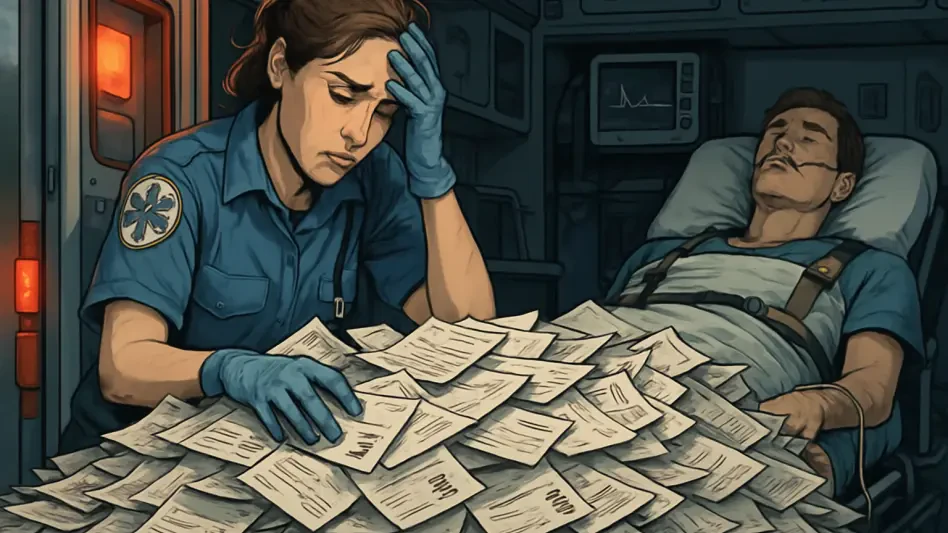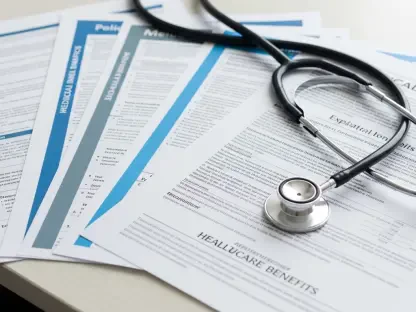What happens when a car accident turns a physician’s life upside down, not just with injuries but with a hospital bill that rivals the price of a luxury vehicle? Dr. Lauren Hughes, a dedicated doctor near Denver, Colorado, found herself grappling with a staggering $63,976.35 charge for emergency ankle surgery and a single overnight stay after a devastating crash. This jaw-dropping figure, slapped on someone who understands the healthcare system better than most, raises urgent questions about the financial perils lurking in emergency rooms across the nation. Her story is not just a personal battle but a window into a labyrinthine system that can ensnare anyone, regardless of expertise, in a web of unexpected costs.
The Nut Graph: Why This Matters to Every American
The plight of Dr. Hughes transcends a single incident, spotlighting a national crisis in medical billing that affects millions each year. Emergency care costs in the United States have skyrocketed, with studies showing that out-of-network bills can average over $2,000 per visit, according to data from the Kaiser Family Foundation. When a patient has no control over where an ambulance takes them, as in Hughes’ case, the financial fallout can be catastrophic. This story underscores the urgent need for transparency and reform in a healthcare system where even professionals can be blindsided by exorbitant charges, revealing gaps in insurance coverage and federal protections that demand public attention.
A Life-Changing Crash and a Shocking Financial Blow
On a crisp February morning, Dr. Lauren Hughes was driving to see patients when a violent car accident shattered her routine, leaving her with a broken ankle and a deep knee wound. Rushed by ambulance to Platte Valley Hospital, the nearest facility, she underwent emergency surgery to repair the damage. What should have been a straightforward recovery took a harrowing turn when the bill arrived: nearly $64,000 for the procedure and a single night’s stay. The sheer magnitude of the charge left her reeling, a stark reminder that emergencies spare no one from financial shock.
The hospital, out-of-network with her Anthem insurance plan, became the first domino in a cascade of billing woes. Despite her insider knowledge as a physician and health policy expert at the University of Colorado, Hughes found herself unprepared for the sticker shock. The initial relief of surviving the accident quickly morphed into dread as she faced a debt that could upend her financial stability, highlighting how quickly medical emergencies can spiral into economic crises.
Systemic Flaws: Emergency Billing as a National Epidemic
Zooming out from one doctor’s ordeal, the issue of emergency medical bills reveals a pervasive problem plaguing the U.S. healthcare landscape. Patients often have no say in where they receive urgent care, especially during life-threatening situations, leading to out-of-network charges that inflate costs dramatically. A 2025 report from the Health Affairs journal notes that nearly 1 in 5 emergency visits result in surprise bills, with costs sometimes reaching tens of thousands of dollars, a trend that shows no sign of slowing.
Insurance coverage, meant to be a safety net, frequently falls short in these scenarios. Limitations in policies, coupled with rising healthcare expenses, leave many Americans vulnerable to financial ruin after a single incident. Hughes’ experience mirrors countless others, where the unpredictability of emergency care locations collides with rigid insurance rules, amplifying the need for systemic change to protect patients from such burdensome outcomes.
Breaking Down the Bill: What Drove the $64K Cost?
Dissecting the components of Hughes’ massive bill uncovers several critical factors that fueled the astronomical total. The primary driver was the out-of-network status of Platte Valley Hospital under her Anthem plan, which automatically escalated the charges compared to in-network rates. This lack of network affiliation meant that standard discounts or negotiated rates were absent, leaving the full brunt of the cost on her shoulders.
Further compounding the issue, Anthem denied coverage for the inpatient stay, asserting that it wasn’t medically necessary based on clinical guidelines for her ankle repair. Despite personal challenges—such as being far from home, without a car, and on opioid painkillers—making immediate discharge impractical, the insurer’s decision stood firm, bundling the surgery and stay into a single rejected claim. This rigid interpretation of necessity left her exposed to the full out-of-network cost.
Lastly, the federal No Surprises Act, effective since 2022, failed to shield her due to the medical necessity dispute. While designed to protect against surprise billing for emergency care, the law’s safeguards hinge on insurer approval of services. Data from the Centers for Medicare & Medicaid Services indicates that thousands of patients annually face similar gaps in post-stabilization care coverage, a loophole that experts argue needs urgent legislative attention to prevent such financial devastation.
Expert Voices and Personal Struggles: A Dual Perspective
To grasp the depth of this billing quagmire, insights from industry experts provide crucial context. Matthew Fiedler, a senior fellow at the Brookings Institution, points out that “the distinction between inpatient and observation status can drastically alter billing outcomes, often to the detriment of patients unaware of the implications.” Similarly, Jack Hoadley, a research professor emeritus at Georgetown University, notes that “post-stabilization care remains a gray area where patients are vulnerable to out-of-network rates if they don’t transfer facilities.”
Dr. Hughes herself offers a poignant view from both sides of the stethoscope. “As a doctor, I thought I knew the system, but as a patient, I was lost in a maze of denials and threats of collections,” she shared, her voice tinged with frustration. Her months-long battle with bureaucracy, even with her expertise, illustrates the emotional and logistical toll on individuals fighting for fair billing, a struggle that resonates with anyone who has faced similar red tape.
Empowering Patients: Steps to Tackle Exorbitant Emergency Bills
Learning from Hughes’ ordeal, there are practical measures patients can take to navigate the treacherous waters of emergency medical billing. One vital step is to closely examine hospital admission status—whether classified as inpatient or observation—since this can significantly impact insurance payouts. Asking direct questions about this classification before agreeing to extended care can uncover potential cost differences early on.
Another key strategy involves challenging insurance denials with persistence. Filing appeals, leveraging support from employer HR departments, or engaging patient advocacy groups can shift the outcome in a patient’s favor. Hughes’ advice to escalate unresolved disputes to hospital or insurer leadership proved effective in her case, suggesting that tenacity and strategic outreach can make a difference.
Finally, understanding the nuances of medical necessity and requesting detailed explanations from insurers can arm patients with the knowledge needed to contest unfair decisions. While not foolproof, these actions empower individuals to push back against a system that often seems stacked against them, offering a fighting chance to mitigate crushing financial burdens after an emergency.
Reflecting on a Resolved Battle with Lasting Lessons
Looking back, Dr. Lauren Hughes’ grueling journey through a $64K medical bill after her accident painted a vivid picture of resilience amid systemic flaws. Her persistence, bolstered by external intervention, eventually led to a resolution where the hospital rebilled her stay as outpatient care, and Anthem covered most of the revised claim, leaving her with a nominal $250 copayment. The hospital’s apology for the distress caused by premature billing added a small measure of closure to an otherwise harrowing saga.
Yet, the echoes of her struggle lingered as a reminder of the broader fight ahead. For countless others who face similar bills without the resources or knowledge to challenge them, the path forward demands actionable reforms—greater transparency in billing practices, tighter federal protections against post-stabilization cost gaps, and simplified processes for appeals. Her case became a catalyst for advocating change, urging policymakers and healthcare stakeholders to prioritize patient protection over procedural rigidity in the years to come.









